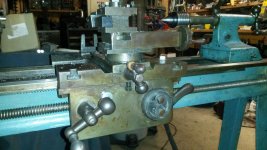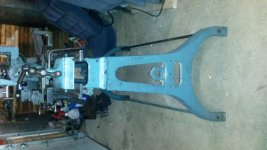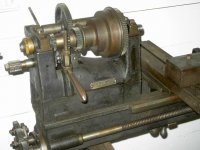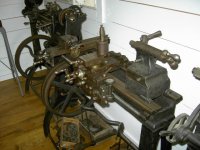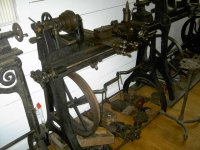Not that good a machinist but I think I see it.
First column "TH" is the thread you wish to cut.
Second column "SP" is the gear used on the spindle of the headstock.
Third column "SC" is the gear used on the leadscrew on the front of the lathe bed.
Fourth column specifies a ratio between the gear used against the spindle/headstock gear and the gear used against the leadscrew gear. Note the 2:1 and 1:2.
Now - how this is used.
You select a thread and find the spindle and lead screw gears and mount them. THEN you pick any gear that is not used to use as an "idler" between the driven and driver gears. A spot is made for this intermediate gear on the "banjo" (bracket adjustable on the outboard end of the head stock.) Any unused gear of the set will do. This is how you do the center most portion of the gear chart where no ratio is shown in the RH column.
For those thread selections where a ratio is shown, you need to find the two gears of your available set that when used present this 2:1 or 1:2 ratio. Use these gears similarly to before at the intermediate banjo position as a "compound gear" which is a gear ASSEMBLY where the gears are held together on a keyed sleeve or bushing found with your gears or other means to prevent relative motion of the two ratio gears. You need to "offset" either the SP gear or the SC gear to allow this to happen (so the gear trains line up.) And yet another keyed bushing should be found among the gears to allow this to happen.
So for perhaps 80 percent of your threading you can use a simple gear train - this is by design. For those less commonly used, you need to set up a compound train. On my lathe I think I've used a compound train ONCE - but details and gear numbers vary between makers. Most lathes require about 13 gears total to cover the entire range of threading most commonly used.
You can check your available gears against this chart and see if any gears are missing.
Hope this helps. As part of your education, get a good book on lathes printed in the early part of the 20th century. There will be more and better description of how to calculate gear trains for making ANY thread count which you can use to check yourself.
South Bend for years published a good book pertinent to their lathes, but a more general book may be more useful to you. I suggest Robert Smith's "Advanced Machine Work" which despite the title isn't nearly so advanced. Can be found online at
http://www.woodworkslibrary.com/repository/textbook_of_advanced_machine_work.pdf or other locations. Nothing like owning a real copy though. Can be found through the online booksellers such as Ebay or Abebooks for as little as $14 delivered (paperback reprint.)
Good luck with that lathe.
Oh, can't forget to warn you. DON'T set up and use a gear train and feed via the lead screw - and then engage the lathe apron clutch which will cause a second carriage feeding action through the lathe feed rod/apron crank. The torque up between the two ratios/feeds will break the lathe.
A very common mistake.
Joe in NH






